Easy to Draw Crocodile Easy to Draw Prianana in Water
Strong, ancient, and powerful creatures, crocodiles make fantastic drawing subjects. Their uniquely textured and colored skin and shape like no other animal gives an artist quite a challenge. If you have ever wanted to learn how to draw a crocodile, then you have come to the right place! In this easy crocodile sketch tutorial, we take you step-by-step through the process of creating a realistic and anatomically accurate crocodile drawing. So, without further ado, let us dive right into the murky waters of the crocodile.
Table of Contents
- 1 Learn How to Draw a Crocodile Step-by-Step
- 1.1 Step 1: Creating the Shape of the Main Body
- 1.2 Step 2: Shaping the Head of Your Crocodile Sketch
- 1.3 Step 3: Laying Down the Shape of the Snout
- 1.4 Step 4: Drawing the Neck of the Crocodile Sketch
- 1.5 Step 5: Outlining the Crocodile's Tail
- 1.6 Step 6: Drawing the Front Leg
- 1.7 Step 7: Shaping the Back Leg
- 1.8 Step 8: Outlining Your Crocodile Drawing
- 1.9 Step 9: Creating Scale Texture
- 1.10 Step 10: Applying the Base Color Coat
- 1.11 Step 11: Contouring the Shape
- 1.12 Step 12: Shading Round Two
- 1.13 Step 13: Creating Highlights and Color Details
- 1.14 Step 14: Adding More Color Details and Structure
- 1.15 Step 15: Finishing Your Crocodile Drawing
- 2 Video Tutorial for our Crocodile Drawing
- 3 Frequently Asked Questions
- 3.1 How do You Add Texture to a Crocodile Sketch?
- 3.2 How do You Create Realistic Coloring in a Crocodile Drawing?
Learn How to Draw a Crocodile Step-by-Step
In this easy-to-follow tutorial, we take you through all the essential steps in creating a realistic crocodile drawing. We begin by covering the basic elements of a crocodile, using construction shapes and lines to build the basic shape. We will then move on to creating the final outline, adding textures, and finally creating realistic coloring.
You can see the outline of our crocodile sketch tutorial in the collage below.
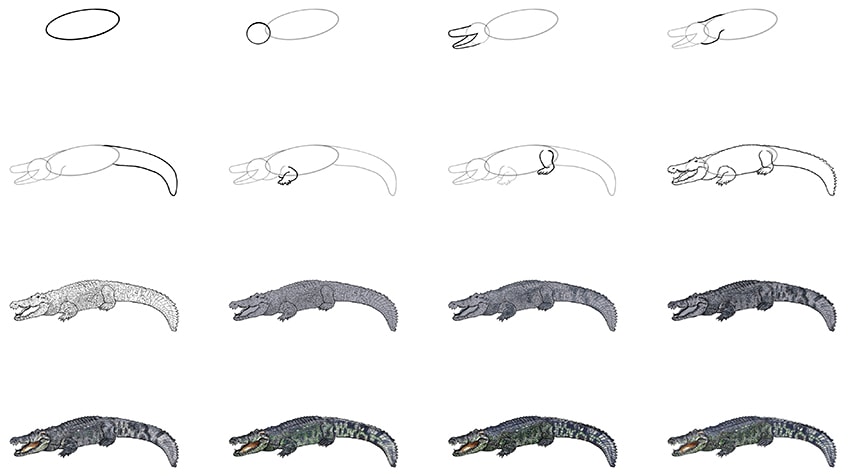
Regardless of your unique artistic style, this tutorial can be easily adapted to suit your needs. Whether you are a graphic artist or you prefer to use more physical mediums like paint or colored pencils, you can simply adjust the instructions to suit your medium.
With that being said, gather your supplies, and let us begin our crocodile drawing.
Step 1: Creating the Shape of the Main Body
To begin drawing a crocodile, it is always a good idea to begin construction with the largest part of the body. In this case, the largest part is the long torso of the crocodile. To represent the basic shape of the crocodile's torso, you can use a very long and narrow oval shape. Slope this oval slightly, with the right side being higher than the left.
The most important thing to consider in this very first step is to ensure that this main body oval sits at the center of your canvas with a lot of space on all sides to accommodate the head and tail which will be drawn in the next few steps.
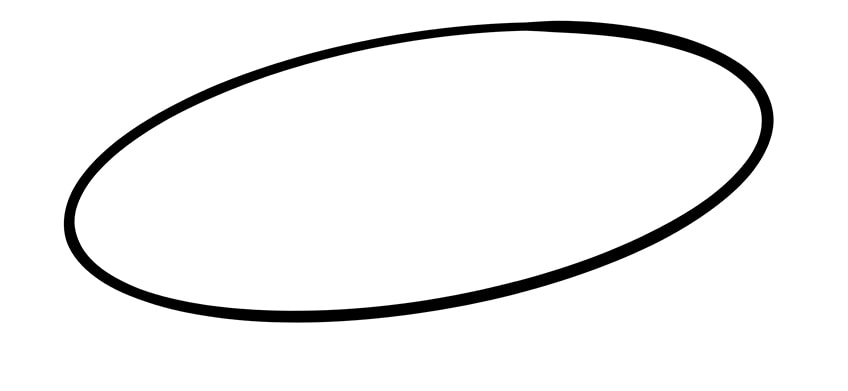
Step 2: Shaping the Head of Your Crocodile Sketch
We are now going to draw the base shape for the head of your crocodile drawing. To do this, you are going to use a very simple circle shape. This shape will only represent the main part of the crocodile's head, not the snout too, as this will come in the next step. Draw a fairly small circle on the left of the main body oval shape.
You want this head circle to slightly overlap the left point of the main body.
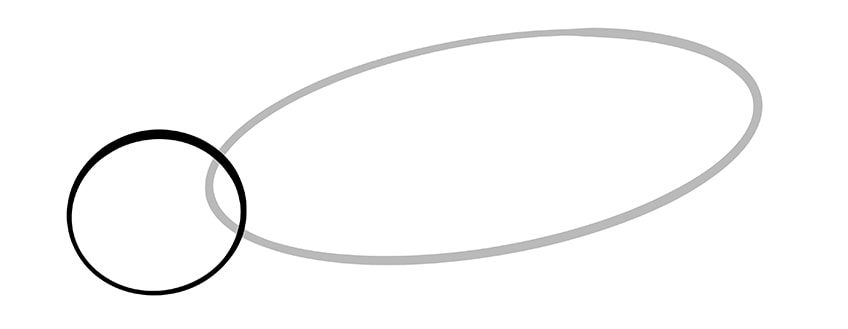
Step 3: Laying Down the Shape of the Snout
Now that we have the head shape in place, we can use it as a base for the snout. We are drawing the jaws of the crocodile open. Begin with the bottom part of the jaw, bringing a slightly curved line forwards and down from the bottom of the head circle. You can then bring this line up and back into the center of the head circle. Take this line out and slightly down again and up to meet the top of the head circle to complete the top part of the snout.
Finish this step by drawing the inner line from the tip of the bottom snout up to the top snout on the edge of the head circle.
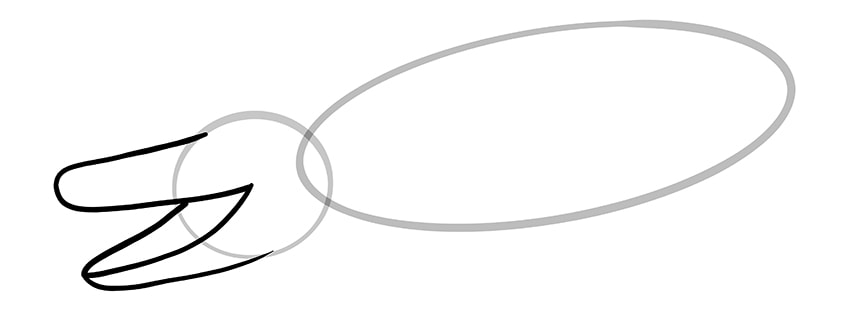
Step 4: Drawing the Neck of the Crocodile Sketch
We are now going to complete the front part of the crocodile drawing by joining the head shape to the main body shape with the necklines. Begin with the top neckline, creating a smooth curve from the top of the head circle onto the top of the main body oval.
Repeat this step for the bottom neckline, but curve it quite sharply up into the main body oval.
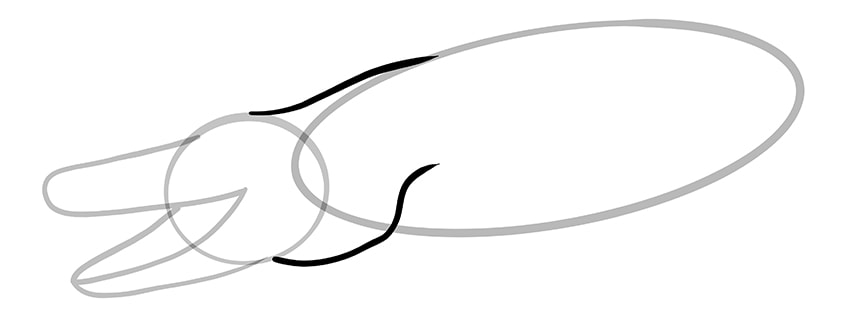
Step 5: Outlining the Crocodile's Tail
Let us now move on to the back half of the crocodile sketch by creating the basic shape of the crocodile's tail. The tail of a crocodile is one of its key features, so it is important that we get the shape right, which is where construction lines start to shine. Begin to draw the tail starting at the top right end of the main body oval. Curve the line down and back to create a long tail that is around the same length as the body and head combined.
Finish the tail shape by curving it back up to join the bottom right end of the main body oval.

Step 6: Drawing the Front Leg
We are now going to begin drawing more detailed elements of the crocodile sketch, starting with the front leg. We are drawing the crocodile from the side on, so only the one front leg is visible from our perspective. Begin by drawing a line that overlaps the main body oval and curves back and down. Create a webbed foot with five toes, and then connect this leg to the neckline with a small curved line.
This is the first real freehand drawing step, so you may need to erase and redraw the shape a few times until you are happy with it.

Step 7: Shaping the Back Leg
As with the front leg, we can only see one of the crocodile's back legs. Use a similar shape to the front leg, but take the thigh much further up into the back curve of the main body oval. Draw the webbed foot with five toes pointing forwards.
This step is the last of our construction steps, and you can see that we now have a great base for our final outline.

Step 8: Outlining Your Crocodile Drawing
It has now come time to create the final outline of your crocodile sketch, using the construction lines as a foundation. Crocodiles have quite spikey scales, particularly on the top of the body. As such, for the entire top outline of the body, draw a spikey line, with spikes that become larger as you move down towards the end of the tail. Begin your outline on the tip of the top jaw, create a little hump and then continue to outline your crocodile sketch adding another little hump on the very top of the head.
While you are at the head, add a little curved nostril at the end of the nose, and create an eye below the second hump. Fill the mouth with small sharp and spikey teeth.
You can then follow the construction lines closely to complete your crocodile sketch. You do not want the outline to be too smooth, so add a little lump and a bump here and therefore a little more realism. Finish your outline by adding little claws to each toe, and then erase any remaining construction lines.

Step 9: Creating Scale Texture
One of the most characteristic features of crocodiles is their ancient scaley skin. In this step, we are going to create this scaley texture with a few different marks. The texture should look a little like boney scales that begin on the top of the head and cover the entire body of the crocodile drawing.
For the best results, these scales should be drawn one at a time, which may be a time-consuming process but the final result will be well worth it.
On the face, you can use small textured marks to give the impression of smaller scales. As you move down the body, you can create lines of ridges across the back that correspond with the spikes in the outline. You can then fill the body with slightly round oval patterns that are of similar sizes. When you get to the tail, you can start to make these scales a little more rectangular, and once again, line them up with the spikes and ridges in the outline.
You can see from our example below, that the majority of the round scales center around the lower half of the crocodile, while the textures on the top can be created with little marks.

Step 10: Applying the Base Color Coat
Crocodiles have a range of different colors throughout their scales, and in order to build up this realistic coloring, we are going to apply it in a few different layers. We begin with a base color coat, which in this case is a light gray shade.
Use this shade and a regular brush (or pen if you are a graphic artist) to fill the entire body of your crocodile drawing.

Step 11: Contouring the Shape
Contouring and shading are one of the most important aspects of creating realistic three-dimensional drawings. In this step, you are going to use a light touch of black paint and a soft blending brush to contour the structure of the crocodile's body. Focus your contouring around the eye, on the top of the nose, within the mouth, on the underside of the neck, on the tops of the legs, along the top of the back, along the middle of the torso, and on the top of the tail.
To give the impression that the tail is bending slightly towards us, add two vertical lines of contouring just before the main curve.

Step 12: Shading Round Two
Now that we have a light layer of contouring, it is time to emphasize the structure a little more intensely. Use a regular brush and some black paint to apply a second layer of darker shading along the contoured areas. Focus the darker shading on the spikes in particular.
The aim here is not to cover the previous contouring, but rather to add intense darkness to the center of it. This will help all of your shading layers to blend more seamlessly together.

Step 13: Creating Highlights and Color Details
In this step, you are going to need a light yellow or tan color to add shading to the inside of the mouth. Add some black shading at the back of the mouth. Next, take a small fine brush and add a touch of white paint to each of the teeth, around the face and jaw outlines, and on the tip of the nose.
Next, take a shade of light green and add this to the same areas with a soft blending brush.
For the rest of the body, use a soft blending brush to fill the scales with highlights of white paint. You can do this throughout the body and tail. Repeat this process with dark green paint, and add color between the highlighted, shaded, and first color coat areas.

Step 14: Adding More Color Details and Structure
We are now going to emphasize the structure of the crocodile using darker and sharper lines. Begin with a blending brush and your green paint, and carefully add the second layer of green throughout the body from the head to the tip of the tail. Repeat this process with a darker green shade and carefully dab the color on the sidewall of the main body. Finish this by using a clean blending brush to blend the colors together smoothly.
Next, use a small blending brush with a little black paint to add a secondary coat of shading to your previous contour areas.
You can then take a sharp small brush with a touch of tan paint to add the final texture to the inside of the mouth. Finally, use the same small brush and some white paint to carefully paint the teeth and toenails on each foot.

Step 15: Finishing Your Crocodile Drawing
This final step is optional, but it creates a more seamless finish. All you need to do is erase any visible outline by tracing them with the corresponding color at each point. Finally, use a sharp brush to add a glint of white to each eye.

Well done for finishing your easy and realistic crocodile sketch! We hope that you have enjoyed the drawing process and learnt a lot from it.
Video Tutorial for our Crocodile Drawing
Frequently Asked Questions
How do You Add Texture to a Crocodile Sketch?
Crocodiles have highly textured skin and capturing this intricate pattern is an essential part of creating a realistic crocodile sketch. In this crocodile drawing tutorial, we show you an easy way to create this beautiful scaley texture.
How do You Create Realistic Coloring in a Crocodile Drawing?
Crocodiles come in a range of different and interesting colors, and we capture these colors in the final steps of our crocodile sketch tutorial. Using a combination of gray, blue, and green tones, we can create a varied and realistic coloring for your crocodile drawing.
Source: https://artincontext.org/how-to-draw-a-crocodile/
0 Response to "Easy to Draw Crocodile Easy to Draw Prianana in Water"
Post a Comment